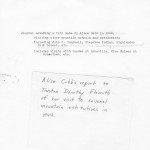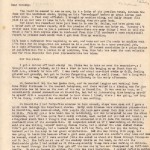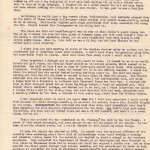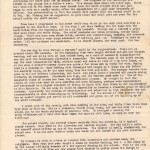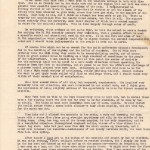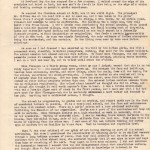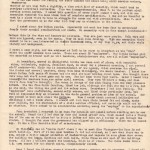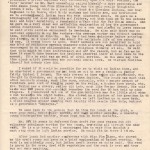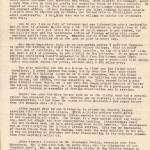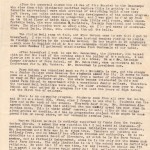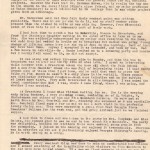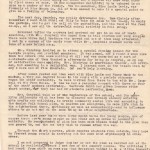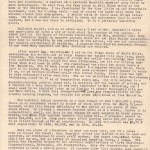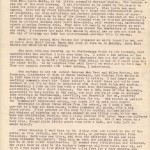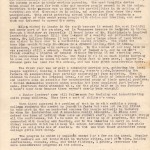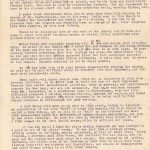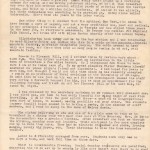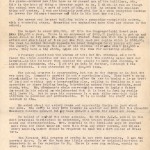Pine Mountain Settlement School
Series 09: BIOGRAPHY – Staff
ALICE COBB 1944 Travel Report to Trustee Dorothy Elsmith
Phi Beta Pi
John C. Campbell Folk School
Cherokee Indian School, Qualla Boundry
Highlander Folk School
Pleasant Hill Academy
Warren Wilson Farm School
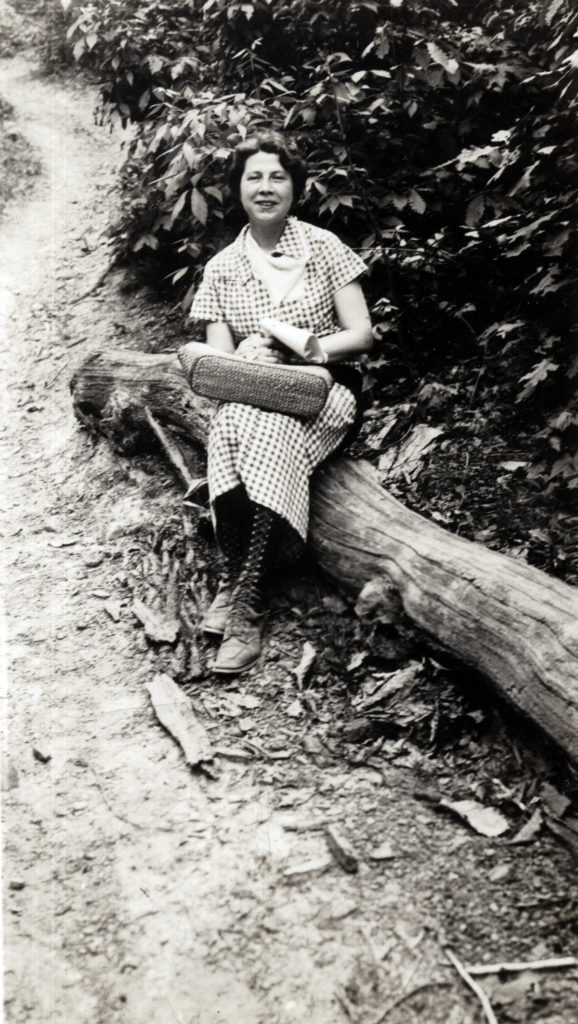
Alice Cobb on log. [cobb_alice_003.jpg]
ALICE COBB 1944 Travel Report to Trustee Dorothy Elsmith
on Visits to Several Mountain Institutions
TAGS: Alice Cobb report, Dorothy Elsmith, WWII, travel report,educational institutions in the Appalachians, mountain schools, Mission Schools, rural settlement schools, John C. Campbell Folk School, Cherokee Indian School, Highlander Folk School, Pleasant Hill Academy, Warren Wilson Farm School, Pi Beta Phi School, Luigi Zande, Ruth B. Gaines
ALICE COBB’S REPORT TO TRUSTEE DOROTHY ELSMITH, 1944, OF HER VISIT TO SEVERAL MOUNTAIN INSTITUTIONS captures not only Pine Mountain’s attempts to bring its work at the School into focus but also reveals the working environment at Pine Mountain after the departure of Glyn Morris, Pine Mountain’s director, who left in 1942 to serve as a chaplain in WWII. Cobb’s trip is a window into the administration and practice of various settlement schools, folk schools, and mission schools in a three-state area in 1944. Her journey provides a snapshot of the post- war years. as the mountain institutions coped with their recovery from the difficult war-time years. Her account captures how the leaders of the various institutions adjusted to the post-war economy and the sobering challenges of maintaining social services and educational programs during a period of economic recovery and shifting priorities.
Alice Cobb’s observations are derived from her direct interaction with the administration and staff at the various schools and is guided by her, always, fresh and subjective perceptions. She describes her reports as a private perspective and one that would serve as the base for a more formal report to the Board. While unrefined, her candid yet perceptive work has left us with a valuable first-hand account of Southern Appalachian experimental schools with their roots in the Settlement Movement. It was during this important period of educational history that some of the most daring and experimental leadership styles of education were born. While sometimes very personal, her reports also reads as her inner journey of discovery as well as a reflection on the demanding re-think of social and economic recovery.
The institutions visited included schools that had their roots in the experiments that grew from Jane Adams and Hull House in Chicago and those forces at work in the unique post-war environment . The grew in communities that were driven by missions similar to those at Pine Mountain Settlement School. The institutions included were:Pi Beta Phi School at Gatlinburg, Tennessee; John C. Campbell Folk School ; Cherokee Indian School in the Qualla Boundary, Indian Territory in western North Carolina ; Highlander Folk School, at New Market, Tennessee ; Pleasant Hill Academy at Pleasant Hill, Tennessee ; and Warren Wilson Farm School at Swannanoa, NC .
Alice also visited with Pine Mountain connections living near and within the range of the various schools, institutions.. These visits included a visit with Luigi Zande and his new family in Asheville and a visit with the Leon Deschamp family at the Warren Wilson Farm School. Of special interest and warm memories was a visit with the much loved former Pine Mountain Settlement School worker, Miss Ruth Gaines, while she was living in Brasstown, North Carolina.
Most all of the individuals in this report are now deceased. However, some few who are mentioned in the report may still be living. We would appreciate being notified of any concerns raised by the sharing of this intimate portrait of the schools and persons mentioned by Alice Cobb in this report and her others.
The “others” include selected documents, correspondence, writing, and administrative papers of Alice Cobb, while secretary to Glyn Morris at Pine Mountain Settlement School, and while serving as the funding outreach for the School. He papers continue to be added to her very rich archival record at Pine Mountain. Her observations, while very much her own, are keenly descriptive and shed considerable light on the relationship of Pine Mountain to its shared communities of interest and how, over the years it related to its fellow travelers and supporters. Some of Alice Cob’s related materials, about people and places, are listed at the end of this page.
GALLERY: ALICE COBB Report to Trustee Dorothy Elsmith 1944
- Alice Cobb. Report to Dorothy Elsmith, 1944. Describes institutions in the So. Appalachians. p. 001a
- Alice Cobb. Report to Dorothy Elsmith, 1944. Describes institutions in the So. Appalachians. p. 001
- Alice Cobb. Report to Dorothy Elsmith, 1944. Describes institutions in the So. Appalachians. p. 002
- Alice Cobb. Report to Dorothy Elsmith, 1944. Describes institutions in the So. Appalachians. p. 003
- Alice Cobb. Report to Dorothy Elsmith, 1944. Describes institutions in the So. Appalachians. p. 004
- Alice Cobb. Report to Dorothy Elsmith, 1944. Describes institutions in the So. Appalachians. p. 005
- Alice Cobb. Report to Dorothy Elsmith, 1944. Describes institutions in the So. Appalachians. p. 006
- Alice Cobb. Report to Dorothy Elsmith, 1944. Describes institutions in the So. Appalachians. p. 007
- Alice Cobb. Report to Dorothy Elsmith, 1944. Describes institutions in the So. Appalachians. p. 008
- Alice Cobb. Report to Dorothy Elsmith, 1944. Describes institutions in the So. Appalachians. p. 009
- Alice Cobb. Report to Dorothy Elsmith, 1944. Describes institutions in the So. Appalachians. p. 010
- Alice Cobb. Report to Dorothy Elsmith, 1944. Describes institutions in the So. Appalachians. p. 011
- Alice Cobb. Report to Dorothy Elsmith, 1944. Describes institutions in the So. Appalachians. p. 012
- Alice Cobb. Report to Dorothy Elsmith, 1944. Describes institutions in the So. Appalachians. p. 013
- Alice Cobb. Report to Dorothy Elsmith, 1944. Describes institutions in the So. Appalachians. p. 014
- Alice Cobb. Report to Dorothy Elsmith, 1944. Describes institutions in the So. Appalachians. p. 015
- Alice Cobb. Report to Dorothy Elsmith, 1944. Describes institutions in the So. Appalachians. p. 016
- Alice Cobb. Report to Dorothy Elsmith, 1944. Describes institutions in the So. Appalachians. p. 017
- Alice Cobb. Report to Dorothy Elsmith, 1944. Describes institutions in the So. Appalachians. p. 018
TRANSCRIPTION: Alice Cobb Report to Trustee Dorothy Elsmith 1944
[A journal covering a trip made by Alice Cobb in 1944, visiting other mountain schools and settlements including John C. Campbell, the Cherokee Indian School in the Qually Boundary, Highlander Folk School, Pleasant Hill Academy, Warren Wilson, and Pi Beta Phi at Gatlinburg. Her notes also include comments on visits with the Luigi Zandes [the new Mrs. Zande, after the passing of Ethel de Long Zande] at Asheville, NC, and Miss Gaines at John C. Campbell Folk School at Brasstown, NC, etc.]
PAGE 1
Pine Mountain July 7, 1944
Dear Dorothy,
You would be amused to see me now, in the lobby of the Lewellyn Hotel [Knoxville, Tennessee], between the desk and the bootblack chair, typing on this “travelogue” before my train leaves just after noon. I feel very official. I brought my machine along, and Emily Creech will pick it up and take it home to P.M. [Pine Mountain] this evening when she goes back.
Now about the record—I have just been in to see Dr. (Clark) Bailey [Trustee], and have given him a brief sort of verbal report, with the promise of a written one later on. However, I’d rather make this one to you a personal letter—there are many things I want to tell you which I don’t want anyone else to read—and from this I’ll condense a more statistical report to present next month when I get back from my vacation.
It’s been a refresher from beginning to end, and here and now I’m ready to confirm what I’ve felt for so long—that our school is in a position to do a more practical job, in a more effective way, than any I’ve ever seen. If honest conviction is a prime factor or qualification for a person in my position, then this trip has been the most valuable one for Pine Mountain that your representative has taken.
Now the story.
I got a rather off-hand start. Mr. [Roland] Pinke was to take me over the mountain — I thought at seven o’clock, so it was a blow to have him banging on my front door at 6:00 A.M., already to take off. I was ready and about one-third awake by 6ish, feeling grieved and grouchy, but got to Harlan forgetting only six small items. Had a long wait there for the bus, and finally got off to Gatlinburg in the early afternoon.
At Cumberland Gap the bus broke down, and we coasted (engine not working) down some dizzy distances to the nearest telephone, and there waited in a blazing sun for the substitute bus to take us the rest of the way to Knoxville. It was over an hour, so I conveniently missed connections at Knoxville, but had an interesting time keeping myself to myself with a companion who wanted to know where I lived, where I was going, how long I’d be there, whether I was married and what I was selling.
At Knoxville I had forty-five minutes to look around, shops were open and I gave a quick look through the department stores. Badly made dresses with atrocious prices — that is Knoxville, much over-crowded, with people who have more money than they know what to do with. Finally got a late local bus to Gatlinburg, and was interested to see the other occupants, most of them quite fashionably attired, much curled and painted and looking so altogether svelte that I thought they must be connected with Pi Beta Phi School, until I overheard some of the conversation. My companion asked me if I was working at Millers, said she was killing herself washing dishes there, had a sister who also washed dishes, didn’t get paid enough, had a husband who had left her flat, and her pap was having the husband put in the army to her great satisfaction. Safe she was living with pap, but was going to leave him because after a girl once got married she couldn’t stay home and then be bossed; asked me if I were married (this was asked me about six times through Tennessee and N.C.) She left me at one of the shadowy trails on the road, as did all the fashionable girls I had marked as Pi Phis—apparently they were also working at Millers. As we wound through the hills they got off the bus one by one and disappeared up different trails.
I saw no houses or cabins, for this was real isolation. I marked definite sudden results of World War II. Probably there is not a log cabin all through there, where some of the members of the family are not flocking to the city to jobs every morning, living the day in the metropolis, and returning to isolation at night. There is something terrifying about this living together of country and city.
PAGE 2
GATLINBURG AND PI BETA PHI SCHOOL
By the time we got to Gatlinburg I was the only one left on the bus. The driver helped me off and I was delighted to find Lois Fenn waiting for me with a friend and a car, to take me to my lodgings. I forgave her in a split second for all the soup beans and corn-starch pudding she inflicted on me last winter. It was good to see a familiar face.
Gatlinburg is really just a big resort place, deliberately, very suddenly plumped down in the midst of those heavenly hills — great stone castles with quaint names — nothing seemed to me to belong. Brilliantly lighted gift shops overflowed with cheap souvenirs all along the way, people looked like foreigners — to the hills, that is.
The place was full and overflowing — I was to stay at Miss Bishop’s guest house, but due to my lateness the room had been given to someone else, and with some relief I went to the hotel [Greystone Hotel, Gatlinburg], a terribly expensive place, and no more artificial than Miss Bishop’s arty little guest house. Miss B., they told me was a Pi Phi, and had been director of the school until quite recently.
I slept late the next morning in spite of the tourist chatter under my window, and the continuous hum of luxurious motor cars outside, I don’t know where the gasoline comes from but apparently there is plenty. Cars were there from every state I could think of.
After breakfast I foraged out to see what could be seen. It seemed to me to be mostly hotels and gift shops, but finally found myself on the school grounds, which seemed to be deserted. For half an hour I saw no sign of life — just smooth green lawns with spraying fountains. Finally [I] accosted a woman who turned out to be the weaving teacher, I asked her about the school but she curtly denied knowing anything about it. She said she taught weaving and that was all she knew or wanted to know about Pi Beta Phi School. She finally admitted that she knew the director, Miss Dyer, whom I had corresponded with, and waved a vague hand in a direction to indicate that Teachers House was that way. I started off then to find that, and tried two or three buildings before I found an unlocked one. This looked like a teachers’ cottage and turned out to be that, as I found later — but for quite a little while I sat in the living room, and read Mountain Life and Work, delighted with a scathing review by Don West, a visitor at P.M. [Pine Mountain] years ago, about Taps for Private Tussie [Jesse Stewart].
I was presently about to start out again for I felt that somewhere I would surely find someone who would divulge something to me about the school, when a Mrs. Nichols tripped up the steps. She admitted she knew Miss Dyer, said cheerfully that they’d been expecting the Pine Mountain representative for two days, She didn’t know much about the school, she just sort of worked there and was a Pi Phi herself, and wasn’t it a sweet place, and so on.
Then a man arrived who was introduced as Mr. Fleming, who said he was the flunky. I asked if that meant principal, and sure enough he was the principal of the school. He had been there for several years, and I really learned at last something about things.
Pi Beta Phi School was started in 1912. It seemed that the national officers of the sorority were searching about for a kind of philanthropy which would develop a serious and cohesive working basis for the sorority and decided to start a school in the southern mountains. They consulted the Department of Education at Washington and were directed to this place in Tennessee which had no school and could not support a public one. And so they started it—first grade through high school, boarding and day school — and in order to help maintain it conceived the idea of developing mountain crafts and creating a paying market.
When the highway was built through this town (the one cutting straight across the Smokies) and the tourists came, those shrewd and opportunist mountain people promptly put up hotels and became rich. The hotels and gift shops are mostly owned today by men who lived subsistently [sic] thirty years ago. Money came fast, and rightly the county began to assume…
PAGE 3
…responsibility for the school, which is now a public county-supported school, the curriculum and staff paid for by county funds. The original Pi Phi buildings are rented to the county for a dollar a year. This change came about two years ago. Since that time all Pi Phi funds have been turned into the craft project which has just begun to work on a profit basis, after the expenditure of a good many thousands of dollars. One understanding is that the county will permit half the school staff to be Pi Phi. Mr. Fleming had no suggestion to give about the total cost per year for the school and/or the craft center.
From here I progressed to the Arrow Craft shop which is the only real activity in progress in the vacation time. At the shop I met Miss Redding who has been with the institution from the beginning and is a Pi Phi herself. Through her I learned a great deal more about the whole thing. The chief products are woven articles, mostly small things. There are some corn-shuck dolls, pottery and wood carvings, baskets, and hammered silver jewelry — not a very large selection of anything just now. Furniture is made on order. All the products are excellent. It is church bazaar, but very good. Not too expensive,
The weaving is done through a weavers’ guild in the neighborhood. There are at present about 100 members. In the beginning they were taught skilled pattern and blanket weaving, and now it is more or less handed down, a sort of community occupation—if one can call the Gatlinburg clientele a community. The weavers come to the craft center, buy the wool (commercially dyed, machine spun) and weave at home if they have looms, or at the shop I believe, anyway there are quite a few looms set up ready for work. Buying would be a problem but Miss Redding with foresight had bought up a large supply before the scarcity began, so for the time being they are well supplied. The younger weavers have gone to war and defense industries, but there are still about a hundred old people making products, on assignment. Standards are high, and the weavers must meet it. One of the expensive items of course has been the educational process. My thought is that the people in this area must be more ambitious and more diligent, perhaps more appreciative and accustomed to a higher standard of living to begin with than those in our neighborhood at Pine Mountain. In our area it would be impossible to develop a sizeable group of skilled workers. Apparently the problem of socialization and education to high standards was not insurmountable or even discouraging at Gatlinburg. And the school at the present time has no social program per se—it is all incidental and grows out of the building up of the craft industry.
I spent most of the morning with Miss Redding in the shop, and while I was there Miss Dyer came to find me. She is a pleasant, fairly young woman, and new not only to this school but to the whole philosophy of mountain work. We arranged a meeting for early afternoon and I went with Miss Fenn who came at that time, to take me over the buildings.
The school itself, now severed almost entirely from the sorority, is a typical county school. Miss Fenn is the librarian and teaches English. She has built a cabin for herself about halfway up one of the mountains. The library is small, exclusively for school use. I am not sure whether books are taken out and loaned in the more isolated places,
No attempt is made to revive or inspire folk literature and customs among the neighbors. Miss Fenn last year taught a class in country dancing, but this was stopped by the county officials because of a law against dancing in the school. This is the only point at which the Pi Phis and the county have clashed in policy since the change in management. The sorority folk hope that a more liberal policy will come about later on.
PAGE 4
After lunch with Miss Fenn I went back to the teacher’s cottage to talk with Miss Dryer. She is so frankly new to the whole work and to the region that our talk was more a general than specific questioning of problems of the area. I was interested in knowing whether or not there is local help— that is whether or not the alumni of the school have been educated to give back, since they have got rich, to the support of the school. Such help is nil, and I think no attempt has been made to get it. There is sympathy and cooperation from the wealthy hotel owners, but that is all. The support comes entirely from the sorority, each local chapter of which has a stated amount to raise for the national project. This is done largely through sales of craft.
My criticism, which perhaps is not quite fair, is that the school is more a device for uniting the Pi [Beta] Phi sorority members over this nation, than a genuine effort to meet the specific social and educational need in the area. It is the root and stem of the Pi Phi organization which probably would fly to pieces without the central responsibility — but not I should think indispensable to the people it sets out to serve.
Of course this might not be so except for the quite unforeseen economic development due to the building of the highway and the influx of tourists. The Pi Phis have probably done the only thing they could do in commercializing crafts, and of course there is great social value in holding up a high standard of excellence to the people of the neighborhood. I can readily see that at this point the center of activity for the sorority could not be moved to a more needy situation without upsetting the sorority from New York to California, but it seems to me that the effort and challenge of a pioneer social project have been lost. Gatlinburg is now and will have to be for all time a dude ranch variety of settlement, really skirting reality. Social workers who want to get their hands soiled will find no challenge there, and I should think very little of their special kind of satisfaction.
Dyer seemed aware of all this, but composed, acquiescent. She inquired very earnestly into our situation, was most interested in our social work, and I think gave the impression of being slightly envious of the opportunity we have for direct community activity.
Miss Fenn took me then to the boys house. They have no boys now, but in normal times have a few staying there who live too far away to be day students, or to come by bus to school. The house is much more luxurious than any of ours, inside. We also visited the health center where a nurse holds clinics — a busy place usually, but not this day, for the nurse was out.
Then Lola and I climbed the mountain to her cabin, a rude and charming one room house with a stone fire place going straight up, chimney and all, in the middle of the living room. Alec, her dog, one of the Creech puppies, is her only companion, and he is a beautiful animal — a thoroughbred shepherd collie, winner of a blue ribbon in a recent dog show. Lois had just come from the short course at Brasstown, and I noted with interest her recorder — reminiscent of our lovely Gertrude Smith, who went there from P.M. this spring.
After supper I just got to the bottom of the mountain and caught my bus to Cherokee. It was early evening, almost twilight before we reached Cherokee, and I simply lay back in the bus seat and looked up and up and up at the mountains — sometimes forgetting that I was even on a bus, and that there were other people there. We might have been the first who ever looked upon these stupendous heights, and depths. When I was conscious of the highway and the purr of the motor, it seemed almost a sinful presumptuous act to interrupt the perfect unity and accord about us — which at the same time protested and ignored the interruption.
PAGE 5
QUALLA BOUNDARY and the CHEROKEE INDIAN SCHOOL
At Newfound Gap the bus stopped for a few minutes. I walked around the edge of the precipice and tried to look, but one can’t do it — It is like being on the edge of a vision and lacking courage to permit a mystic experience,
We reached the Cherokee school at 8:30, but it was still light. The principal Mr. Gilliam was at the road with a car to meet me, and I was taken to the girl’s house where I stayed overnight. The matron in charge, a Mrs. Smith, was an Indian woman, pleasant and anxious to make me comfortable. The building was a large one, very well built white frame house. I had a lovely room over looking the school grounds, which looked like a neat New England village, with wide streets, and small houses most of them white, lawns and side-walks — good looking and functional as one would expect in a federally financed project, without imagination or originality. One feels a certain impersonality if that is the word. My room was simply furnished, the only evidence of Indian atmosphere being the wastebasket, and the curtains. In the living room near by were some Indian paintings.
As soon as I had dressed I was escorted up the hill by two Indian girls, one with a permanent wave, cheerful, talkative youngsters, working, they said for the summer holidays. The school session had closed several days before. We found Miss Flanagan, the one indispensable person it seemed, in the back yard of her little cottage, painting waste baskets. I sat on a lard can near by, and we talked until about ten o’clock.
Flanagan Is a fairly young woman, about my age I judged, except that she is so ter important t1 i. she seemed much more grown up, She manages the farm and buildings, teaches home economics, crafts, and other things, plans the meals, Hows all the buying for the school, supervise the canning— etc. etc. I began to wonder as she recited all this, if anybody else did anything. She has been there ten years, came from Oklahoma, and worked in other Indian projects before this one. She — it was a Horatio Alger sort of story in the first person, and I must say that I did not care much for Miss Flanagan — but she is certainly a hard worker and devoted to her job. Anything but a cultivated person.
The school is progressive, no grades and no credits, and report cards are in the form of anecdotal letters to parents. It is a vocational school and the farm and maintenance are done with student labor. There is a girls’ matron and a boys’ adviser evidently fulfilling the function of our counselor. Crafts are a part of the curriculum and they are sold in markets. Miss Flanagan insists on a high standard of work in basketry, which is her specialty. Weaving is marketed also. I saw no weaving there except curtains in the houses, very beautiful things, made of G.I. millends from the last war. They also have all kinds of clothing from the other war. I saw some of the men workers wearing the cowboy type of uniform hats so familiar in those days. Wool is homespun and vegetable dyed.
Miss F. was very critical of our policy of not having weaving as part of the school curriculum. But when I questioned the practicality of training girls to be skilled weavers through a long tedious process of years, when they will probably not be able or wish to continue with it after school days, she answered vaguely that it was nice to know and kept them busy or something of the sort. They ought to have some culture. I did not continue the discussion because I sensed then the old disagreement about what constitutes culture, and thought Miss F. for all her accomplishment, had no knowledge or interest in the intangibles, as Dr. Hatcher would say.
PAGE 6
I did ask about the feeling the staff members had about being civil service workers, whether or not they felt a rigidity, a blue print kind of security, which would tend to paralyze individual initiative. This was incomprehensible. Miss F. is the perfect civil service person anyway. I asked this question of every staff member I met, and with one exception received the same blank look of complete mystification. I was and am thankful to work in a place where we have to struggle for money and with personalities. Miss F. said that the government is so far away that they pay no attention to the school.
I asked about the Indian people. Apparently not much has been done to understand deeply their special peculiarities and needs. No community work is done except incidentally.
Perhaps this is the wise and democratic attitude. They are just more people. Folk sayings and lore are ignored, even in the music. They do ball room dancing. With one exception there seemed to be no one interested in who the Cherokee were, or why they were, and their whole history and background.
I spent a cozy night, and was awakened at 7:00 to be taken to breakfast at the “Club” where the staff members have meals, there are about 80 “employees”. The little Indian girl who escorted me around told me that teachers, administrators, etc., are all called “employees”.
At breakfast, served in a delightful little tea room sort of place, with beautiful china, tablecloth, napkins, excellent food, in every way a pleasant occasion, I met several staff members — Mr. Blair who is Superintendent of the Agency, which oversees the school, the doctor and several teachers, among them Miss Mittleburg, the music teacher. I asked her about Indian folk music and dances but she said she knew nothing about them. She thought there were some but she’d never gone out to see. She had been there four years, later I heard this comment — the teachers here are under civil service. They work 48 hours a week, and when that’s done they’re through. The person in charge of the club dining room was very pleasant indeed. She was from North Carolina, liked her job, although she felt she was in a rut, but as she said, the living was good and the salary sure. Everywhere I had that feeling. The “employees” were comfortable, economically secure, and liked their particular jobs, but felt no responsibility or interest in the whole general problem or idea of the school. No-one seemed to know much about the Indians. When I asked about personal initiative and challenge I met a blank stare, I should add that Supt, Blair looked fat and sleek, spoke poor English, was the characture [sic] of a civil service official, and certainly could not be an educator. There seemed to be considerable cowtowing [sic] among the “employees” to the superintendent.
From breakfast I returned to my room for notebook and pencil before starting out to see the school. Found that I had shut my door and locked myself out, which caused quite a flurry. One of the men on the place had to bring a ladder and take out a screen to get through the window. I thought for once the government had slipped up in efficiency. There was no second key. It was a Pine Mountain kind of catastrophe.
Our first stop was at “Qualla Hall” where I was to meet Mrs. Flanagan — the Home Ec[onomics] and craft building: Part of it was open but Miss F. had not arrived, so I saw what there was to see, mainly a rather meager collection of woodcarvings and baskets in some glass-shelved cases. The building was large, spacious and well built, white-frame as are most of the buildings there. All are, I believe, except the hospital, which is of stone. The whole looks like a H. B. [? N.E. New England ?] town except for the church spire, conspicuously absent.
Next, I found the kitchen where a gigantic canning program was in progress. I found all the teachers there stuffing spinach into half gallon jars, a crowd of pleasant, rather weary young women. All the teachers, same as the other employees, are on an 11 month time schedule and after school session is over they do farm and housework. They can everything and last year filled 45,000 jars, about 20,000 half-gallons altogether, They also have a dehydrator where they prepare onions, beans, etc. They told me onions and beans were most successful. The dehydrator was put together by student and staff-labor and the cost was something over fifteen dollars. They explained how It worked, but I couldn’t understand it.
PAGE 7
From the kitchen I proceeded to the administration building, and In the principal’s office happened very fortunately upon the boys’ advisor. The “boys’ matron” as Mr. Hart cheerfully called himself — a most personable and wide awake young man from Minnesota who was the only really thoughtful person I met. He told me a good deal about the Cherokee Indians, how they happened to be there, what their customs and habits were, and Introduced me to several small Indian boys who were clustered about. He gave me a bibliography and some pamphlets he folded, and then took me to the science hall and boys’ dormitory, a ramshackle affair with the Far House smell. And he gave me a very clear and satisfying explanation of how the government school functioned. He had been there for a year and planned to leave because he said civil service employment is deadening. He also said there was no cultural sympathy among the workers—the average worker was without imagination, initiative or dynamic. Mr. Hurt had been a minister before entering the service, so I questioned him about the religious life of the school, if any. It seems there is none. Staff members are not permitted to hold any kind of religious service whatever with students, and students are not encouraged to do any philosophical or religious thinking at all. He said that this might be done individually and off the record, but so far as he knew It wasn’t done because the teachers observed their 48 hour week to the moment. [Separation of church and state?] This he said was an evil of civil service. In the same way the time-clock spirit prevented any personal social work. He visited families himself but nobody else did.
I asked if it would be possible for me to visit an Indian home, and he chartered a government car and took me out to see a family — a family fairly typical, I judged. The only person at home was the old grandmother, who thought in Cherokee, and spoke very broken English. The house was much like other mountain shacks, much like ours, actually, with a merger amount of furniture, some sort of wrapping paper on the walls, a broken down porch, etc. Mrs. Taylor was a cheery, smiley old lady, much like Granny Creech [Aunt Sal]. She told us she was 90 years old —- she couldn’t remember the word for 90 but held up nine fingers. I discovered that one of the grandchildren was the little girl whom I had talked to the night before. She showed us a picture of her grandson In the army — with great pride and joy, and when we left invited us to come back. I could imagine myself working very happily with people like this, but not as a government “employee.”
We came back to the school just in time for lunch at the club, A very good meal, beautifully served, and I met another employee, a charming young kindergarten teacher, whose home was in North Carolina.
Mr, Hart it seems is deferred from draft for some reason but did volunteer ambulance service for two years, traveling all through the Near East. He is a printer, and I encouraged him to make Pine Mountain his next stop when he left Indian service. He would fit In there I think,
After lunch had another conference with Miss Flanagan, who showed me the craft rooms and gave me a brief explanation of basket weaving. The work is undoubtedly good, but Indian craft leaves me quite cold, The reed is grown in the area, dyed with vegetables and the work is neat and true but not very exciting.
There was just time to get back to my room and get my bag ready to make the afternoon bus. I was charged no guest fee, but it was suggested that a small gift would be welcome for “extras.” Mr. Hart took me to the village, and I was interested in the scene which I hadn’t seen the night…
PAGE 8
…before, because I’d got off the bus alone to the school. The village was obviously fixed up for tourists with Indians in feather costumes doing the popular idea of war dancing, smoking peace pipes and beating tom-toms, and so on. I saw several smart care and overheard some of the tourists who were pawing over the souvenir counters. They seemed a little frightened and deliciously impressed with these “real honest to goodness” Indians.
ASHEVILLE and ALLANSTAND
The road to Asheville from Cherokee was not nearly so beautiful as the one I’d traveled the night before, but it was an interesting ride, and I rather was sorry to get to Asheville, which looked like just another big small town. I called Mrs. Zande [the second Mrs. Zande] who was expecting me — and drove over at once to pick me up.
Mrs. Zande is charming — a sophisticated, very lovely little person, deeply interested in everything about Pine Mountain and very much in sympathy with the progress which has been made. Glyn and Gladys [Morris] had visited them several years before.
From the environment I felt very much at home and with friends. Mr. [Luigi] Zande came in just before dinner. He is superb, so simple and gracious and so glowing with kindness. I decided that both the Mrs. Zandes had done well. He speaks good but rather broken English and I was glad for my experience with Italian people because I understood him easily and it pleased him. After dinner we sat in the garden until dark. It was much like Pine Mountain, with lovely roses, a pond and fountain, all beautifully and lovingly created, We talked and talked and talked and I was amazed at how well he remembered every single one of our neighbors from the oldest to the youngest. I heard story after story of the old days. After dark I showed them the slide pictures which they were quite delighted to see. They made me feel that I had brought them a very special evening. Certainly they gave me new love for Pine Mountain. I believe I succeeded in interesting them in making a visit to the school.
Mr. Zande is employed with the Enka Rayon Company. They are comfortable but not wealthy people, simple, straight forward and friendly. I was interested to see Ethel de Long Zande’s picture prominent in the living room, and to see the deep admiration and affection with which they both regarded her.
We talked until 1:00 a.m. and found it hard to stop. Toward the end I must have seemed tired, as I was, because with a charming smile Mrs. Zande exclaimed, “You are both so fascinating that I’ve forgotten to think of time, and here it is past midnight and time for coffee.” We had coffee and reluctantly went to bed. It was that kind of evening — glowing to the last moment.
Next morning over a leisurely breakfast Mrs. Zande told me a great deal about Ethel de Long whom she worshiped, and about her own problem — stepping into the position of Mr. Zande’s wife. It couldn’t have been easy, and I think one of the reasons they have not ever returned to Pine Mountain is that they were not sure what their welcome might be in the community, Any lingering wonderings in my own mind about all this were exploded. I still marvel at Caroline’s honest independence, but their marriage is just as right as it could be, She is opposite in every way from the first Mrs. Zande — is tiny, rather quiet, not in any sense a public kind of person, and she is much younger than Mrs. Zande. Ethel de Long would surely have wished just this kind of life for her husband and her children. Well — this isn’t my affair, but since Mrs. Zande was so willing to share her confidence with me I have accepted it in the same spirit with gratitude and appreciation. Certainly at Pine Mountain the most [———————page cropped]
PAGE 9
[What] was left of the morning I spent in Asheville, mostly at Allanstand where again the name Pine Mountain was magic. Miss Bloxton, the manager, spent a long time with me talking crafts and comparing those of various schools. The regret of course is that Pine Mountain is no longer represented in the charmed circle. It was fortunate that she liked talking so much because I didn’t need to express any opinions, and indeed have no Intelligent ones about handicrafts. I do think they may be willing to handle our calendars this fall.
All in all I am so full of interest and new information about handicrafts though that if someone should drop a hat I’d volunteer to reopen them at P.M. The problem is that just about the time we could expect to get started, the war will be over and the inevitable influx of foreign articles will crowd American crafts from the market. Especially as these can be duplicated by machine made articles which are just as good in every way.
WARREN WILSON COLLEGE (FARM SCHOOL)
Mr. Zande came about 4:15, and we had coffee before I left for to spend the evening and night at Warren Wilson College. This Is an hour out of Asheville, In a beautiful location, on top of a hill overlooking over a sort of plateau to other hills in the distance. It is a much more imposing institution than I’d expected to find from its former name “Farm School for Boys.” It was until about three years ago a vocational high school with a companion school for girls, Dorland Bell, a few miles away.
The main building and the one I came to first was the former boy’s dormitory. I never learned its name, but up over the front door where the name of the building should be if it were anywhere, was a big black sign that said “No Smoking.” I was taken into the building and Introduced to Miss Carson, the matron, who was expecting me. There seemed to be a good many elderly women about, and I saw very few young people because, of course, the school session was over and it happened that at this particular time a sort of conference or assembly of foreign missionaries was in session.
Supper was over but Miss Carson took me to the dining room and a special supper was prepared for me. Mrs. deVries was my hostess, the sister-in-law of Johanna deVries, who had been the nurse at Pine Mountain a few years before when the Newmans were with us.
After supper Miss Carson invited me to attend the evening vesper services with them and two others. I felt a little dubious about going to church in my meager travelling dress —sandals and no stockings — but It was apparently all right. The Chapel is a very modest small log building, neat and simple and very Presbyterian looking. Attendance was small and the services were led by a missionary from South America. The atmosphere was so very religious that I felt a little stifled. This was my impression of Warren Wilson from the No Smoking sign over the main building to the end. It was as stifling as Cherokee had been disconcerting in its complete separation from anything religious.
After vespers I called on the Deschamps family, recently come from Brasstown. Mr. D. [Leon Deschamps] was with P.M.[S.S.] in early days [and] was the originator of our “Perfect Acre.” Mrs. D.[Deschamps] was May Ritchie, sister of Una Ritchie Yahkub [an Indian Hindu] of Boston, and a former student of Pine Mountain. I went with Mrs. D. and her daughter Carol, a Berea graduate, to an outdoor concert at Dorland Bell hall, a girls dormitory, a very beautiful little stone building. Most of the buildings were of brick. This was beautifully situated on the edge of the plateau, looking out to hills in a distance, although I rather begrudged the time spent with Victor Herbert [victrola records ……..?].
PAGE 10
I really wanted to see the college. It was restful and perhaps just as good a way of taking stock of the whole set up as walking about among the buildings now overflowing with missionaries.
After the concert I showed the slides of Pine Mountain to the Deschamps who viewed them with distinctly modified rapture (this is getting to be a favorite expression), were most critical of everything built since they left there, and quite uninterested in any developments of the school program. It was a disappointing meeting altogether, and I was glad to find my room on the third floor of Keith Hall, very rude little cell rooms, small, uncomfortable beds, the very minimum furniture, frankly functional and nothing else. The missionaries were on every side, and I heard waves of conversation about India, China, etc. coursing through the halls.
The rising bell rang at 6:15, and Miss Carson came to see that I got to breakfast. I ate with her sister, whose husband teaches reading to people in foreign countries by the phonetic method. He has taught In 92 languages –only once In English which is the one language which he speaks. There were also some famous (I gathered) missionaries from Guatemala at our table.
After breakfast I went to see Mr. Bannerman, the director, who talked with me for the rest of the morning about the policies of the school. I can clearly see where Glyn received many of his ideas. He and Dr. Randolph, former director of Farm School, and Mr. Bannerman, were co-workers in the Conference for S. [Southern] Mt. Workers. Mr. Bannerman Is president now.
Farm School was organized much as Pine Mountain is now, and the change to a Junior College came because the students asked for it. It seems to have come as a logical, gradual development from a number of students who wished to stay on for graduate study, the state became interested in this and asked Farm School to experiment with a vocational Junior college. Therefore the Dorland Bell buildings were sold, the older students came over to Farm School and were united in a program for the last two years of High School and the first two of college.
There is no community program. Students come from all over the south, and there are about 500. Fees, alas I forgot to ask about. Students run the farm and do the work of the school. They work half days. Mr. Bannerman disagreed with Glyn’s idea that children can too easily spend too much time in routine work. This is their chief quarrel, he said, although the college gives grades and credits, and has no progressive project which might be compared with our co-op store, or our community service year.
Warren Wilson College is entirely supported by funds from the Presbyterian Church. I asked the same question that I had asked at Cherokee — if control from above tended to limit personal initiative among staff members. Mr. Bannerman said this was in no sense true. Teachers and workers are entirely free, and he himself has complete freedom and authority. He is responsible to a general Board of Directors, of which he is the Farm School member, and is virtually independent, since he is the only one who knows much about Farm School. The only limitation is that the school must be definitely religious. He said that if at any time, for any reason, he should see fit to suggest (as he, of course, would never do) that religious services be omitted or curtailed, the Board would object — except for the stipulation it is all up to him. If he needs a new building he plans it, estimates the cost and asks for a grant. There is usually not any trouble about securing extra grants for legitimate needs.
Nothing has been published about Farm School except one or two articles…
PAGE 11
…in the national Presbyterian magazine. No appeals are made for funds except as the Board of Home Missions asks for general funds for all national projects. However, the fact that Dr. Hermann Morse, who is really the top man in the church in the rural field (Glyn’s close friend and my major professor at Union Seminary) Is more interested in the college than in any other project, gives them an advantage.
Mr. Bannerman said that they felt their weakest point was written publicity. There was no one person to do it, and no staff member at the present time who wished to write or was able to. However, from [a] financial point of view this is not a necessary part of their work.
I had just time to catch a bus to Asheville, thence to Brasstown, and found the Deschamps daughter [Carol Deschamps] waiting in the outer office to take me to my bus. She was evidently embarrassed by my rather cool reception in the home, and said they had waited to invite me to breakfast but mother was going through change of life and she never knew how she would feel in the morning. Part of that may have been true, anyway I accepted it as intended, and took my bus. Had a few hours in Asheville — Mr. Zande invited me to a swimming party and lunch but I hardly felt equal to it, so did not accept.
BRASSTOWN and JOHN C. CAMPBELL FOLK SCHOOL
It was a long and rather tiresome ride to Murphy, and then the bus to Brasstown was an hour and thirty-five minutes late. I spent an interesting while however with a Brasstown woman who knew all about the Folk School and a man from Shootln’ Creek who was full of hair-raising tales (I told Henry Creech some of these when I got home, and he said that went to prove the folks at Pine Mountain wasn’t the only liars in the world!) These people are distinctly different from ours — much more talkative and on the surface at least, more alert. Very much interested in all strangers. I was asked the usual questions — “How old I was; where’d I came from; where I was going; and whether I was married.”
At Brasstown I found Miss Pittman waiting for me. She is the weaving and dying teacher, a very charming woman, reminding me of K. [Katherine] Wright, [Abby] W. Christensen] and others of the old Pine Mountain workers. We were met at Keith House by Mrs. [Olive Dame] Campbell, and Mrs. Bidstrup [Marguerite Butler] who welcomed me very cordially. Mrs. Campbell fixed supper for us and we had a short visit in the perfectly lovely clinic room. They were expecting a group from West Georgia State Teachers’ College for the week end, and the group arrived just as we finished supper.
I had time to dress and was taken to the party by Mrs. Campbell and Miss Gaines, who seemed glad to see me and to hear about Pine Mountain. The party was delightful; besides the visitors there were several young people from the community. I joined in the dancing and enjoyed it tremendously. Everyone was In a festive spirit and I particularly enjoyed George Bidstrup’s dancing. He is worth seeing and knowing.
Every smallest thing was done to make me comfortable and welcome and I sensed something of the hospitality which visitors to Pine Mountain in the old days have talked about. This was my first example of how we can improve our ways at Pine Mountain. We must make our guests feel like guests Instead of roomers, or intruders. My room was next to Miss Gaines [Ruth B. Gaines] and there…
PAGE 12
…were also two or three girls on the floor, Miss McClelland who does puppets and marionettes, (Fanny Mack) and Ethel and Elly — we all knew each other by first names at once. It was altogether delightful to be ushered in at once as a member of the family. The house mother, Miss Louie [Louise ?] Davis, was formerly at Pine Mountain. All of them seemed to make it a special point to give me a feeling of belonging,
The next day, Saturday, was really a strenuous one. Immediately after breakfast I went with Ethel and Elly to take the milk to the Co-op, to empty the garbage, and to get the mail at the post office, and the feed at the feed co-op, so I saw all the extra folk school activity in full swing.
Returned to find the carvers had arrived and sat in on one of their sessions, with Mrs. [Olive Dame] Campbell who urged them to tell stories and sing. There were three Hall brothers who carved and one of them sang afterward. I sat in a corner of the music room while Mrs. Campbell checked words and tune of a new ballad song.
Mr. [George] Bidstrup invited me to attend a special dancing lesson for the Georgia people, and provided sneakers. It was grand, and I found I knew more than the others (who knew nothing at all) and was accepted as a sort of assistant — one of them thanked me afterwards for being so helpful, so my cup of satisfaction was complete. Mr. Bidstrup is a marvelous teacher, not critical, but exacting in a delightful way. I learned more in the lesson than in any I have had at Pine Mountain. One can’t help learning.
After lunch rested and then went with Miss Louie and Fanny Mac to the museum, a very old dogtrot house In the woods with a prairie schooner wagon the chief curiosity. We were invited from there to tea with Mrs . Campbell at the Farm House. At tea we had a recorder concert with three or four of the staff members performing. Gertrude Smith had given lessons at the short course, where they had had 32 students performing.
Mrs. Campbell told us of the beginnings of the school, and its underlying philosophy which has been to discover and develop already existing arts, crafts, and abilities, to create community social life and according to the Danish Folk School plan, to enliven and enlighten, to make life rich in the neighborhood there, spiritually as well as economically — and to influence others to go out and do the same thing in other neighborhoods. [MISSION STATEMENT]
Before last year there were three month terms for young people, now of course there are no young people so the whole set up moves to community activity. No readjustment of plan has been made because this is the plan the target are geared to, and the one they wish to resume after the war.
Through the short courses, which receive students from outside, they hope to interest young people in carrying out the same kind of philosophy in other areas.
I am not prepared to judge whether or not the plan as carried out at the school Is realistic [ ….. ?] because I met few of the country people. The criticism I had heard from other sources was that Brasstown tended to be a little Shangrila for the staff members. Certainly it is something of that, and I confess that I felt much drawn to the kind of life they lead— completely free of any feeling of routine, gracious, cultivated, inspiring personally surrounded with comfort and beautiful things. They seen to live richly. I can’t say whether such living is likely to make me sleek and smug and ingrowing. Compared with our turbulent life this seems too undemanding.
PAGE 13
Following the discussion of theory we had a long talk about folk dancing and folk music. The Folk School has done much to foster and preserve these here and elsewhere. I learned of a Kentucky Mountain mummers’ play which we must investigate. We went from the Farm House to Mill House which is the home of the Bidstrups. I was fascinated by the tiny little up and downstairs apartment, with the winding stair — and of course the water mill under the kitchen window lent atmosphere. I should think it would make things rather damp. The house seemed more adapted to charm and uniqueness than to solid comfort, but I was not there to criticize. It is a perfectly beautiful place.
Followed supper, and as at other meals I sat at Miss Campbell’s table and sandwiched in quite a bit of talk about the running of the school. I asked just how the “Board of Trustees” functioned, and Mrs . Campbell said they had no function except to approve actions which she and Miss Butler undertook— they take no Initiative in any activity of the school, and are not consulted— but usually are advised of activity. I suppose this will be entirely changed if and when Mrs. Campbell and Mrs. Bidstrup are retired.
After supper Mrs. Bidstrup [Marguerite Butler] and I sat on the front steps of Keith House, overlooking the valley, and to hills beyond and talked till very late about finances. She seemed to enjoy — of course she really did — looking over those wide cultivated fields, which had been wilderness, not fit for raising anything when they came in 1925. She reminisced too about her early years at Pine Mountain. She is much concerned about the country dancing there. Feels that it is losing form, and is eager for some permanent staff member to carry it on, to be trained professionally with school funds. Since Glyn has left we have evidently fallen very far. She is not satisfied with Miss Christensen’s technique, since it is as of twenty-five years ago. All this relates to a misunderstanding several years old, is entirely off the record of course, and I include this only because it was very important to Mrs. Bidstrup, and I shall need to be reminded later on to discuss it rather thoroughly with you and Miss Wells. I feel very incompetent about having any responsibility in the country dancing problem, but realize its prime importance at Pine Mountain.
The Campbell school operates on a cash budget of about $33,000 a year, There is no endowment except an Income of about $500 from the Doris Ulmann bequest, which will belong officially to the school at the death of John Jacob Niles. Or perhaps a separate bequest comes at his death. Anyway it is comparatively small , and they do not reckon it very largely in their plans. Crafts, and income from current sources (tuitions etc., I presume) amount to about $14,809, and the Farm pays about $7000 leaving about $10,000 per year to be raised through gifts and contributions. In 1942 the school was 86,70 % self supporting; in 1943, 88.30 %; and in 1944, 83.5 %.
Only one piece of literature is sent out each year, and this comes with an appeal for funds. Mrs. Campbell writes the leaflet which is read and approved, or criticized by every staff member. She makes occasional talks about the school, but no effort at organized speaking tours, I judge. The school was formerly helped by the national organizations of three churches — Congregational, Episcopal, and Presbyterian. Only the Presbyterian Board continues to make a yearly grant, (I learned later that Russell Sage [Foundation] recently made a rather large grant for the craft program. )
After this I showed the slides to several of the staff people and had a demonstration of Fanny Mack’s puppets given me and thought them adorable. The puppet course is offered as an alternative to wood carving in the short course.
PAGE 14
Morning came quickly and I packed my bags, before going to Sunday School with Miss Louie Davis, at the little community Baptist Church, The teacher was one of the wood carvers. I was flattered to be asked by two people to leave the adult group and join the “young people”. Miss Louie was much amused. This was my first introduction to a large and representative group of neighbors, for they definitely are farther advanced than most of ours — most of these folk seem to be of the Creech ilk–I was reminded of the little country church which my cousins and I attended when we visited grandmother’s farm in southern Indiana many years ago — plain, self respecting, hard working, square shooting farming folk. They were not nearly so picturesque as most of our Kentucky mountain people — the ones around the headwaters of Greasy at any rate. I wondered how much Pine Mountain School has or has not done in the way of keeping our folk too picturesque — perhaps this is heresy.
Back at the school Miss Gaines had prepared an early lunch for me, and we had a nice visit before Fanny Mac [Mack] came to take me to Murphy. Both Miss Gaines and Miss Louie went along.
MONTEAGLE and the HIGHLANDER FOLK SCHOOL
The next ride was standing up to Chattanooga which is the busiest, most unattractive bus station I have ever been in. I spent a few minutes at the station studying my map, and noticed that Monteagle was not far off my route to Pleasant Hill, so I called to Highlander Folk School to ask if I could come for the night there. To my surprise they said they’d be very glad to have me. They are usually crowded with labor unions, I understand.
[I] was curious to see the school because Don West and Miles Horton, the founders, classmates of Glyn at Union Seminary, had visited Pine Mountain in 1932 when they were looking for a place to settle. I had heard most exciting comments about the “labor school”, and went there not quite sure whether or not I’d be able to understand what they were doing and saying. Incidentally, I rode on the bus with a woman from Chattanooga, going to Louisville, for the short distance. She was a DAR, knew of Pine Mountain, apparently is very active in DAR [Daughters of the American Revolution] work, and said she would like to arrange some meetings in Chattanooga, Asheville, and Nashville for me and possibly Atlanta, which could be good new territory for us. She warned me against the “Communist” Highlander School, and hoped I’d be safe that night I
Monteagle is about three miles from the school, so I took a taxi out—It is a big old farm house, rather pleasant old place, with a big front porch. I was greeted at the door by two cordial college girls - had visions of sleeping on a double-decker in the living room, which was bare and utilitarian looking, had a piano covered with labor rags–so differed from the cozy, arty loveliness of the J.C.C [John C. Campbell], school. But I was taken to a very nice, though plain little guest room with a bath, and then left to amuse myself.
After dressing I went back to the living room and I talked to two of the girls, one from Antioch, one (a colored girl, or perhaps Phillipino) from Wellesley, both were new there, and they did different things and were doing research “projects”, They told me what the projects were and all had to do with Labor organization. It seemed very intellectual and involved. The girls took me over to the Horton’s home—an old farm house near by, and there I was lucky to find Miles Horton quite free for a rare evening and glad to talk. He was most interested to have a visitor from Pine Mountain, asked about Glyn [Glyn Morris], and apparently regarded Glyn as a fine piece of potential liberal material that somehow got stiffened and lost from the ranks. He gave me a graphic story of Highlander from its inception, occasionally interspersing regretful remarks about Glyn’s early progressivism, and what he might have done if he hadn’t [gone] conservative it seemed a great tragedy.
PAGE 15
The idea really grew at Union [Theological Seminary] through Reinhold Neibuhr, and with his encouragement the two boys started out to build a school which would help the common people in their various pursuits. The most tangible device which could be used for both city and country people seemed to be the union, therefore their purpose was to explore the portability’s in the uniting of workers–see what they could do in units, and organize them where they were unorganized. This meant gathering around them as staff and students a large number of wide awake young people with vision and Idealism, and send them out informed to spread the news.
Miles wished to locate in the south because it seemed the most fruitful and needy part of the country, or in Tennessee because he had grown up there. Through a minister at Crossville [TN] (I heard later of Mr. Nightingale‘s inspired leadership at Pleasant Hill) they learned of a wealthy and philanthropic woman, Mrs. Lillian Johnson (I believe), who had a large piece of land which she wished to turn over to a worthwhile social project. She liked the boys. (One couldn’t help it– Miles is a dynamic person, full of ideas, enthusiasm, bursting with nervous energy. In the course of our long talk he was scarcely still a second. Words sort of jumped out, and he couldn’t finish smoking a pipe full of tobacco without emptying it and starting over. This nervousness is like Glyn’s [Glyn Morris]. One feels there is so much inside hurrying to come out that he needs to move and think fast to keep pace.) Anyway, Dr. Johnson gave the land for the school, and has also given considerable money.
The first year was largely a community service one, gathering the local people together, holding a nursery school, women’s clubs, interesting the farmers in cooperating (not strictly cooperative) farm activity. Then it widened to follow the original ideal, and now all kinds of industrial unions and leaders come in sessions for concentrated study of their special problems. A United Automobile Workers union session had been completed just before I came. Gertrude Smith attended this, and the girls told me it was fortunate I hadn’t come then because there weren’t nearly beds enough.
A Junior leaders camp will follow soon for training and indoctrinating quite young children. They have a sort of children’s camp.
Then there appeared the problem of what to do with ambitious young college students who needed to learn the facts but were not really fitted to take part in the concentrated courses for people actually in industry to whom the instruction and the sessions really belonged. So Miles conceived the idea of letting them come as student staff, to stay straight through all the conferences, but to be used in the setting up of programs, the detail[s] connected with housing and feeding, and in the interim to carry on individual research which would keep the school informed and instruct the girls (they’re all girls now of course). So that was what those attractive young college girls were doing.
The program is entirely un-planned except for a few months ahead. Regular staff members are out in the field in various cities, most of the time, holding conferences, classes, etc., and their findings, I gather, determine the more concentrated programs at the school.
At the present time there is no community social work except for the nursery school. I may be mistaken about this. The community people are sympathetic and cooperative, which seems rather wonderful to me considering the natural conservatism of rural southern people.
PAGE 16
Workers are un-salaried but their expenses are paid wherever they are. The budget is about $15,000 a year more or less, all but $5000 of this is paid by the unions which are aided by the school, and by the farm and dairy which furnish food. The work is done by neighboring farmers. But, all housework is done by the student staff who take turns preparing meals, washing dishes, etc.
I asked about recreation which has in past days been folk dancing in charge of Mr. Toeferteller, now in the army. “Teffy” came to Pine Mountain one summer and electrified our family by his dancing. I learned to my pleasure that the program has recently been in [the] charge of Mrs. Fahs’ daughter Lois Fahs Timmlns, my very good friend.
There is no religious life of any sort at the school and it does not seem to enter into their thinking except as better living conditions will produce better people.
Miles feels that economic security will in the end assure good citizenship. He makes it too simple. I cited the sad example of the wrong affects of too much pay for our people who do not know what to do with cash. He graciously forebore answering that that problem was ours – the educational one. He did say that the bad effect appeared first but that continued security would gradually produce higher living standards. I still feel that he makes it too simple. Economic security is not the whole answer.
No work has been done with coal miners organizations because the miners he says are the most difficult group in industry — the most ignorant, and the most hard-headed — his words.
Many quite well known people come there out of curiosity or with more serious interest. A. J. Muste came to visit but was not much impressed because they are not specifically pacifist. They, in general, tend individually [to] support the New Deal, and are not Communist. The South was much annoyed when Mrs. Roosevelt, on a celebrated tour to Chattanooga, when the city officials prepared a rousing welcome for her, ignored the welcome and asked to be invited to a Supper party which happened to be being held by Folk School students in Chattanooga the same evening.
I left Miles with much on my mind to think about, trying to readjust my connotation of the word “folk”– I asked him exactly why this should be called a Folk School, and he said it is “folk” in its broadest and most real sense — they serve the interests of common people everywhere, not just in one small locality. He says the John C. Campbell Folk School is not a folk school in the true Danish sense, which is national not local.
At the big house I found the girls making lemonade and was invited to a party in one of the girls’ rooms. It was just like a college spread, sitting around on the beds, mostly unclothed, and full of small talk. Cathy Winston, a charming girl from Berea and secretary for six years, was the only one who easily knew much about the school. She showed me the office, upstairs, and either part of the bedroom or next door to it—a very busy looking room with two rickety old typewriters, and stacks of mimeographed and typed things having to do with the labor unions.
I went to bed to the tune of “I dreamt I saw Joe Hill” or something of the sort. In the morning the girls came to waken me and Eva had prepared breakfast which we ate with more collegiate small talk, always invigorating to me although I no longer speak the language, or perhaps haven’t the accent.
PAGE 17
I kept inquiring about community work and wondered if there was any cooperating work open to women’s groups. Immediately they thought up a thrilling scheme for making and marketing patchwork skirts,and by the time breakfast was over they had ordered several million yards of material from the textile union, and built up a million dollar business. Of course it was all talk, but their enthusiasm was something to be marveled at. Cathy alone smiled tolerantly. She’s been six years in the labor world.
One other thing — I learned that the mythical Don West, who seems to have become a sort of legend, and not a very creditable one, poet and radical, is now principal I believe of a school in Georgia and has stayed three years in the same job, to everyone’s amazement. He became too radical for Highlander Folk School, and broke off with Miles Horton shortly after the school began.
Zilpha Horton took Cathy and me to the bus station and I was interested to meet Miles’ father and mother who live in a cabin on the grounds — typical mountain farmers, perfectly delightful people. The cabin seemed to have only one room, and there were ever so many people coming in and out, restaurant fashion.
So— on to Pleasant Hill and I arrived there by devious ways about 6:50 P.M. The bus driver carried me past my destination to the little town of Crossvllle [TN] a few miles beyond. So I telephoned from there to make sure I could be taken care of. To my great pleasure Victor Obenhaus himself answered the phone (Glyn’s [Glyn Morris] friend and classmate) . I had hoped for years to meet him, but thought I would not this time since he has recently accepted a position as professor of rural sociology at the University of Chicago. He said that he was just on his way out for the evening — it seemed the staff were having a farewell banquet for him, but we made an appointment for the following morning and I went on out to Pleasant Hill on the next bus, to spend the night.
I was welcomed by the secretary and taken to my room — a very pleasant one. I was tired out, and went to bed early thankful for a long night of rest from traveling. I could feel the good spirit there—a neat white Congregational town sort of place, it seemed, oozing gentility and good cheer. The students (summer family) below seemed to be having a party, in the absence of staff members, and I went to sleep to the tune of Mairsy Doats [sic].
The rising bell rang at six and one of the girls came to take me to breakfast in a dining room very much like ours at Pine Mountain. Mrs. de Jarno the housemother was a gracious hostess. After breakfast she took me through the kitchen, canning room and laundry. Their equipment is far more complete and up to date than ours. They had an electric dishwasher and stove, ironing mangle, lovely big dryer, etc. Their dietitian is also the home economics teacher.
Labor is differently arranged from ours. Students work only one or two days a week, and work full time on those days.
There is considerable freedom. Social dancing and smoking are permitted. Otherwise the whole set up is amazingly like ours except that there is no wood working department for boys. Single staff members have a sort of large apartment, living away from the students.
I went from there to keep my appointment with Mr. Obenhaus who is so much like Glyn [Glyn Morris] that I was shocked. He exudes enthusiasm– took me all over the school grounds, doing little things as we went along, cleaning the printing…
PAGE 18
…press which some careless boy had left inked, rolling the truck’s spare tire up to the garage — he seemed to have a finger on every big and little thing about the place — ordered new fire hose as we passed one of the buildings, etc, This is the kind of thing a director ought to do, I think — it was as though the school were all a sort of part of him, so that he sensed the smallest thing off center. I was particularly grateful for his warm reception because he leaves for Chicago tomorrow and this is his last day really.
The newest and largest building holds a gymnasium — completely modern, with a wonderful stage. Dramatics are emphasized more than any course in the school.
The budget is about $60,000. Of this the Congregational Board pays $16,000 a year. There Is an endowment of $600.00 (“Nothing to get up and shout about, is it?” said Mr. Obenhaus!) Student fees are what the parents can afford and about half of them pay the full cost per capita which is $350.00. The rest is raised through appeals to local Congregational groups all over the country, and through the sale of old clothes, which nets about $14,000 a year. They have a big store, open all the time for marketing cloths [sic].
I frankly questioned the wisdom of this but Mr. Obenhaus said he had faced the whole question and was convinced that the clothing sales were not harmful— to the contrary they enabled the people to have good clothes, to learn good standards, etc. I didn’t go into it further, although I was not convinced. I was attracted by the $14,000 item.
The school program is progressive but not to the degree or in just the way ours is. Community service is not a curriculum plan. They have a co-op store similar to ours. He looks forward after the war to buying a large tract of land and working out a homesteading plan, selling to families on a cooperative or share holding basis, introducing modern farming methods, food stock, etc. Mr. Obenhaus’s whole conversation seems to imply a future interest in his school so wholehearted that it is hard to feel he really will leave it. But he says his successor is a much abler man — his whole attitude is generous and enthusiastic, It is no wonder his staff are so devoted to him.
He asked about our salary range and apparently theirs is just about the same. His salary is only $200 however as against our $250 for our director; teachers receive $110.00 but pay back $30.00 a month for board and room.
We talked of some of the other schools. He thinks John C. Campbell School is the most practical institution in existence, with truest vision of mountain needs and characteristics. Mrs. Campbell is his ideal — he says he learned more from her about mountain work than from any other person, and thinks every mountain worker should be required to take the short course at Brasstown.
The Pleasant Hill program of crafts is not very impressive. I saw two carvers there. To me the work has little character or originality— that at Brasstown is so far superior to it. There is some rug making, mostly to order. No weaving.
We suddenly discovered that it was time for my noon bus, so Mr. Oberhause went racing up to the main building for my bags, just as Glyn [Glyn Morris] moves, fast, and I was breathlessly off on the bus for Knoxville, with warm invitations to return. A long but lucky trip back to Harlan with a seat all the way even on July 4th— tonight at the Lewyllen Hotel and tomorrow morning the early train to Putney, and over the mountain with the mail man. It is 1:30 A.M.
SEE ALSO:
Alice Cobb – Biography
Alice Cobb – PMSS Notes, November 1927
[Issue edited by Alice Cobb]
Alice Cobb – with Edith Cold at Big Laurel (19–)
Glyn Morris Letter to Alice Cobb, 1976
RELATED:
LEON DESCHAMPS & MAY RITCHIE DESCHAMPS
HIGHLANDER RESEARCH AND EDUCATION CENTER RECORDS, 1917 – 2005 (Link)
PLEASANT HILL ACADEMY (Link)
JOHN C. CAMPBELL FOLK SCHOOL (Link)
CHEROKEE BOARDING SCHOOL – QUALLA BOUNDARY (Link)
PI BETA PHI SCHOOL [Arrowmont] (Link)
WARREN WILSON FARM SCHOOL (Link)

